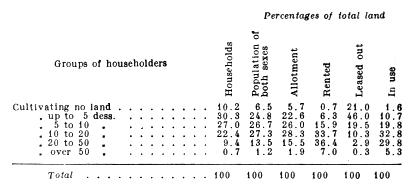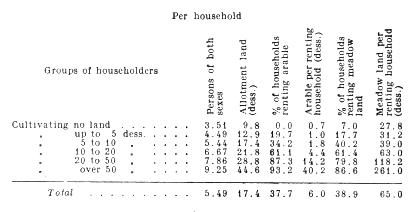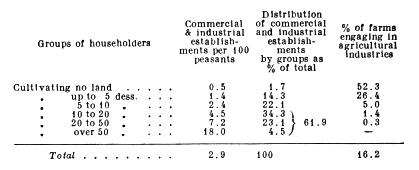
In our review of Zemstvo statistics let us now turn to a gubernia where conditions are totally different: Perm Gubernia. Let us take Krasnoufimsk Uyezd, for which we have a household classification made according to scale of farming.[1] Here are the general data regarding the agricultural part of the uyezd (23,574 households, 129,439 persons of both sexes).

Hence, here too, notwithstanding the considerably smaller areas under crops, we find the same ratios between the groups, the same concentration of crop areas and animals in the hands of a small group of well-to-do peasants. The ratio between the land held and the land in actual economic use is the same as in the gubernias with which we are already familiar.[2]

The same grabbing of rentable land by the well-to-do peasants, those already best provided; the same transfer of allotment land (by leasing) from the poor to the affluent peasantry; the same diminution of the role of allotment land, proceeding in two different directions, at both poles of the countryside. To enable the reader to get a more concrete picture of these processes, we give the data on land renting in greater detail:

In the top groups of peasants (who, as we know, concentrate in their hands most of the rented land), land renting is consequently of an obviously industrial, entrepreneur character, despite the widespread view to the contrary of the Narodnik economists.
Let us pass to the data on hired labour, which are particularly valuable as regards this uyezd owing to their completeness (specifically, data have been added on the hiring of day labourers):

We see here a clear refutation of the view of the Saratov statisticians that the hiring of day labourers is not a characteristic index of a farm’s strength or weakness. On the contrary, it is a supremely characteristic index of the peasant bourgeoisie. In all forms of hiring by the day we observe that the percentage of peasants who hire labourers increases together with the increase in economic strength, despite the fact that the most affluent peasants are best provided with workers in their families. Here, too, family co-operation is the basis of capitalist co-operation. Further, we see that the number of farms hiring day labourers is 2 1/2 times (average for the uyezd) the number hiring seasonal workers—we take the hiring of day labourers for reaping; unfortunately, the statisticians did not give the total number of farms hiring day labourers, although this information was available. In the three top groups, of 7,679 households 2,190 employ farm labourers, while 4,017 households, i.e., the majority of the peasants in the well-to-do group, hire day labourers for reaping. Of course, the hiring of day labourers is by no means specific to Perm Gubernia, and if we have seen above that in the well-to-do peasant groups from 2 to 6 and 9 tenths of the total number of proprietors employ farm labourers, the direct conclusion is the following. The majority of the well-to-do peasant households employ hired labour in one form or another. The formation of a body of regular farm labourers and day labourers is an essential condition for the existence of the well-to-do peasantry. Lastly, it is extremely interesting to note that the ratio between the number of farms hiring day labourers and the number employing regular farm labourers diminishes from the bottom peasant groups to the top. In the bottom groups the number of farms hiring day labourers always exceeds, many times over, the number employing regular farm labourers. In the top groups, on the contrary, the number of farms employing regular farm labourers is sometimes even larger than the number hiring day labourers. This fact clearly points to the formation in the top groups of the peasantry of farms employing labourers, farms based on the regular employment of wage-labour; wage-labour is more evenly distributed over the seasons of the year, and it becomes possible to dispense with the more costly and more troublesome hiring of day labourers. Let us quote, incidentally, the returns on hired labour for Elabuga Uyezd, Vyatka Gubernia (the well-to-do peasants are here merged with the middle peasants).

Assuming that every day labourer works one month (28 days), the number of day labourers will be three times the number of seasonal workers. Let us note in passing that in Vyatka Gubernia, too, we find the already familiar ratios between the groups as regards both the hiring of workers and the renting and leasing of land.
Very interesting are the household data on the use of manure, cited by the Perm statisticians. Here is the result of an analysis of these data:

Thus, here too, we see a profound difference in the systems and methods of farming employed by the poor and the affluent peasants. And this difference must exist everywhere, since the well-to-do peasants everywhere concentrate in their hands the greater part of the peasant-owned animals, and have more opportunities for expending-their labour on farm improvements. Therefore, if we learn, for example, that the post-Reform “peasantry” have at one and the same time created a group of horseless and cattleless households and “raised agricultural efficiency” by adopting the practice of manuring the soil (described in detail by Mr. V. V. in his Progressive Trends in Peasant Farming, pp. 123-160 and foll.), this quite clearly shows us that the “progressive trends” simply indicate the progress of the rural bourgeoisie. This is seen even more distinctly in the distribution of improved agricultural implements, data regarding which are also available in the Perm statistics. These data, however, have been collected not for the whole of the agricultural part of the uyezd, but only for its 3rd, 5th and 4th districts, comprising 15,076 households out of 23,574. The following improved implements are registered: winnowers 1,049, seed-sorters 225, threshers 354, totalling 1,628. They are distributed among the groups as follows:

One more illustration of Mr. V. V.’s “Narodnik” thesis that improved implements are used by “all” peasants!
The data on “industries” enable us this time to single out two main types of “industries,” indicating 1) the transformation of the peasantry into a rural bourgeoisie (ownership of commercial and industrial establishment), and 2) the transformation of the peasantry into a rural proletariat (sale of labour-power, the so-called “agricultural industries”}. The following table shows the distribution by groups of these diametrically opposite types of “industrialists”[3]:

A comparison of these data with those showing the distribution of the area under crops and the hiring of workers once again shows that the differentiation of the peasantry creates a home market for capitalism.
We see also how profoundly the facts are distorted when the most varied types of occupations are lumped together under the heading of “industries” or “employments,” when the “combination of agriculture with industries” is depicted (as, for example, by Messrs. V. V. and N.–on) as something uniform, identical in nature and precluding capitalism.
Let us point in conclusion to the similarity of the data for Ekaterinburg Uyezd. If from the 59,709 households in the uyezd we subtract the landless (14,601 households), those having only meadow land (15,679 households), and those neglecting their allotments entirely (1,612 households), we get for the remaining 27,817 households the following data; the 20,000 households that cultivate no land or cultivate little (up to 5 dess.) have an aggregate area under crops of 41,000 dess. out of 124,000 dess., i.e., less than 1/3 . On the other hand, 2,859 well-to-do households (with over 10 dess. under crops) have 49,751 dess. under crops, and 53,000 dess. of rented land out of a total of 67,000 dess. (including 47,000 dess. out of 55,000 dess. of rented peasant land). The distribution of the two opposite types of “industries” and also of the households employing farm labourers in Ekaterinburg Uyezd is shown to be quite similar to the distribution of these indices of differentiation for Krasnoufimsk Uyezd.
[1] Material for the Statistical Survey of Perm Gubernia, Krasnoufimsk Uyezd, Vol. III: Tables, Kazan, 1894. For purposes of comparison we shall quote later the main data for Ekaterinburg Uyezd, for which the same classification is given. Statistical Returns for Ekaterinburg Uyezd, Perm Gubernia. Published by the Zemstvo of Ekaterinburg Uyezd, Ekaterinburg, 1891.—Lenin
[2] The total allotment-land held by these peasants (all groups) is 410,428 dess., i.e., an “average” of 17.5 dess. per household. Then the peasants rent 53,882 dess. of arable and 597,180 dess. of meadow land, making a total of 651,062 dess. (households renting arable—8,903, and renting meadow land—9,167) and they lease out allotment land—arable—50,548 dess. (8,553 peasants) and meadow land—7,186 dess (2,180 peasants), making a total of 57,734 dess.—Lenin
[3] “Agricultural industries” are also singled out only for the last three districts. The commercial and industrial establishments total 692, namely 132 water-mills, 16 oil-mills, 97 pitch and tar works, 283 “smithies, etc” and 164 “shops, taverns, etc.”—Lenin
| | |
| | | | | | |